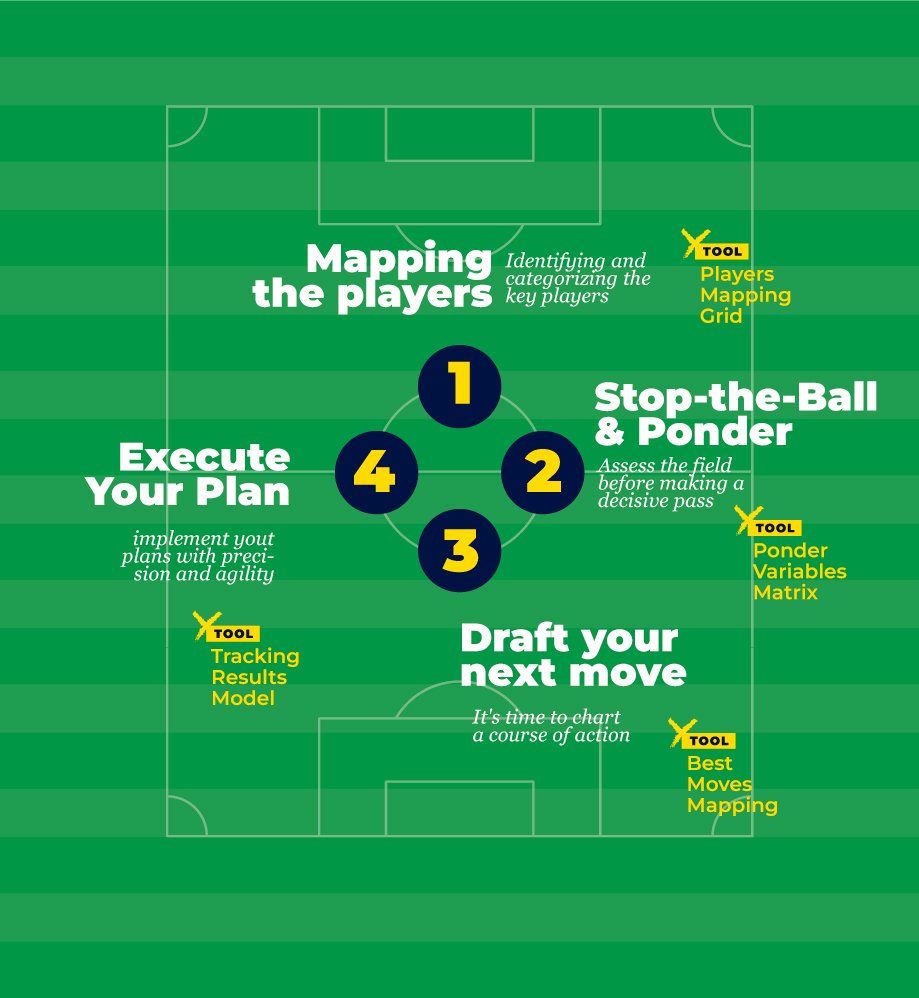Growing up as the daughter of a passionate football fan and ex-professional player, I was deeply immersed in the world of strategy surrounding “la pelota” (as we call it in Argentina). My father, with his unwavering enthusiasm for the game, not only imparted his love for football onto me but also instilled invaluable lessons about the importance of strategy, anticipation, and decision-making—particularly during that pivotal moment known as the “stop-the-ball” moment.
But what exactly does the Stop the Ball Technique entail? At its core, it’s a methodology designed to dissect the intricate dynamics of players, variables, and actions within a business context. Just as a football team must navigate through defenders to score a goal, businesses must navigate through obstacles to achieve growth and success.
The Stop the Ball Technique encompasses four distinct phases:
1. Mapping the Players:
This phase involves identifying and categorizing the key players within the business ecosystem—those who contribute to or hinder growth across various domains such as marketing, sales, finance, and client relations. By understanding the roles and interactions of these players, businesses gain valuable insights into their operational landscape.

HOW (Methodology for this phase): Players Mapping Grid
It all starts with understanding the primary goal and the micro-goals necessary to achieve it. This involves breaking down the main target into smaller, manageable steps. To facilitate this process, it’s essential to grasp the concept of MicroGoals, which encompass the critical areas required for success. For a comprehensive exploration of MicroTargets, I recommend reading our article, “Tackling Micro-targets for Growth.”
In essence, every Growth Goal must be dissected into its constituent parts to identify the key drivers of growth, essential activities, primary responsibilities, and dependencies such as budget, personnel, and tools. Throughout the micro-goals process, each Business Development Manager (BDM) commits to specific outputs and may request resources like budget allocation, access to tools, or additional personnel to facilitate their attainment. These BDMs serve as the key players for each growth goal and its corresponding micro-goal, akin to star athletes on the field.
Have you already mapped out your players? Excellent! Let’s proceed to the next phase.
2. Stop-the-Ball & Ponder:
Much like a skilled midfielder pausing to assess the field before making a decisive pass, business leaders must take a moment to reflect and analyze. This stage entails scrutinizing data, identifying growth blockers, and delving deep into the underlying reasons behind these challenges. It’s a critical juncture where thoughtful consideration and strategic planning lay the groundwork for future success.
HOW (Methodology for this phase): Ponder Variables Matrix
It all begins with pinpointing where the blockers lie. To achieve this, we must first grasp the GAP between actual and forecasted results. For insights into forecasting growth, I recommend delving into our comprehensive article, “Analyzing the GAP: Actuals vs Forecast.”
In essence, the GAP analysis involves breaking down every Growth Goal into its constituent parts to uncover the key drivers of growth, essential activities, primary responsibilities, and dependencies such as budget, personnel, and tools. Each activity is also tied to specific timelines, facilitating easy management under Project Management principles. Any delays in timelines or goals can significantly impact the final forecasted results. Conducting an “Opportunity-Cost” Analysis allows us to gauge the cost of delayed actions and results, with attributions made to each area/R-RACI.
Therefore, it’s crucial to pause, ponder the most critical drivers, and gain a thorough understanding of the game at hand.
3. Draft your next move:
With insights gleaned from the previous phases, it’s time to chart a course of action. Collaborating with relevant stakeholders, leaders must devise strategies to address root causes and overcome obstacles. Utilizing tools such as the MVP model, Hypothesis Mapping, and other strategic frameworks, businesses can test hypotheses, formulate actionable plans, and map out their path to success—much like plotting plays on a football field.
HOW (Methodology for this phase): Best Moves Mapping
After identifying the primary areas and activities acting as blockers (variables), it’s crucial to delve into their root causes. Why are they falling short of their forecasted results?
Each variable requires careful analysis regarding:
- Adjustability of Blocker-Reason: Can this obstacle be overcome through specific actions? If so, what resources are needed—people, tools, budget—and when can we expect to see results? If the answer is “no,” then we must explore:
- Alternative Solutions: What alternative approaches can yield comparable results or come closest to the forecasted outcomes? What are the associated costs and resource requirements—people, tools, budget? What are the revised forecasted results?
By addressing these questions, we gain a deeper understanding of our options, can fine-tune our projections, and develop a clear strategy outlining the necessary moves and key players to keep us in the game.
3. Execute Your Plan:
With a well-defined strategy in hand, it’s time to execute. Just as a forward executes a carefully crafted play to score a goal, businesses must implement their plans with precision and agility. As they navigate through the complexities of the marketplace, they must remain adaptable, learning from setbacks, refining their approach, and continuously striving for improvement.
HOW (Methodology for this phase): Tracking Results Model
The Growth Mapping Matrix not only enhances our understanding of each area but also highlights the importance of each activity, its corresponding KPIs, and the detection of deviations in key drivers. We recommend conducting weekly progress reviews across all departments, with Sales and Marketing undergoing reviews three times per week.
During this phase, it’s imperative to swiftly identify deviations and propose corrective actions. The most effective approach to corrective action is to pinpoint the GAP, solicit alternative solutions from each leader to enhance results, and refrain from halting the initial Driver implementation. Instead, introduce a new option and run both for at least two weeks, considering the impact of these adjustments on the Growth-Cost-Ratio. In the worst-case scenario, this may entail a double cost, but it mitigates the risk of failing to achieve desired results, which could jeopardize an entire growth plan. It’s akin to having a weak player on your team and risking an entire season’s outcome.




